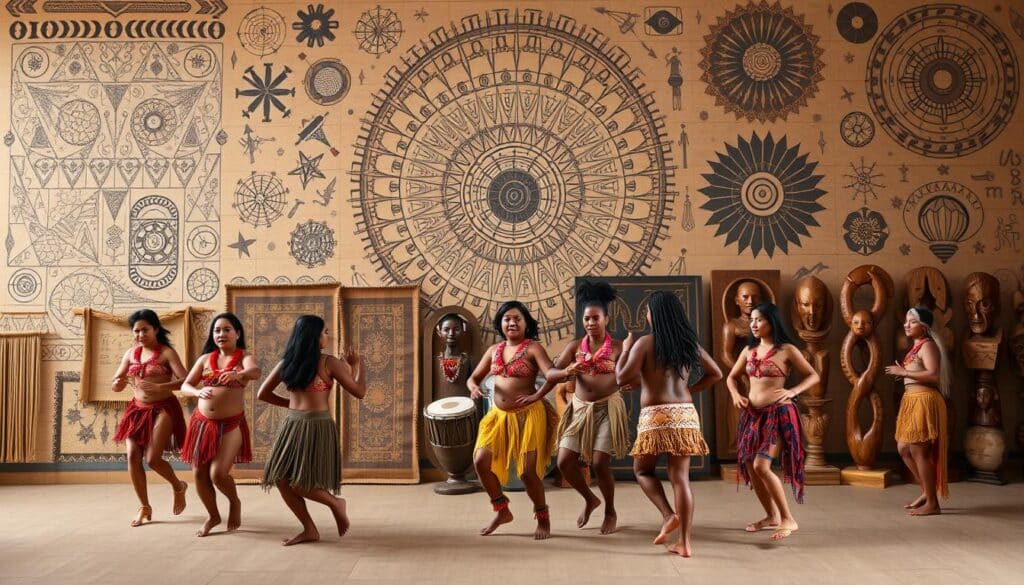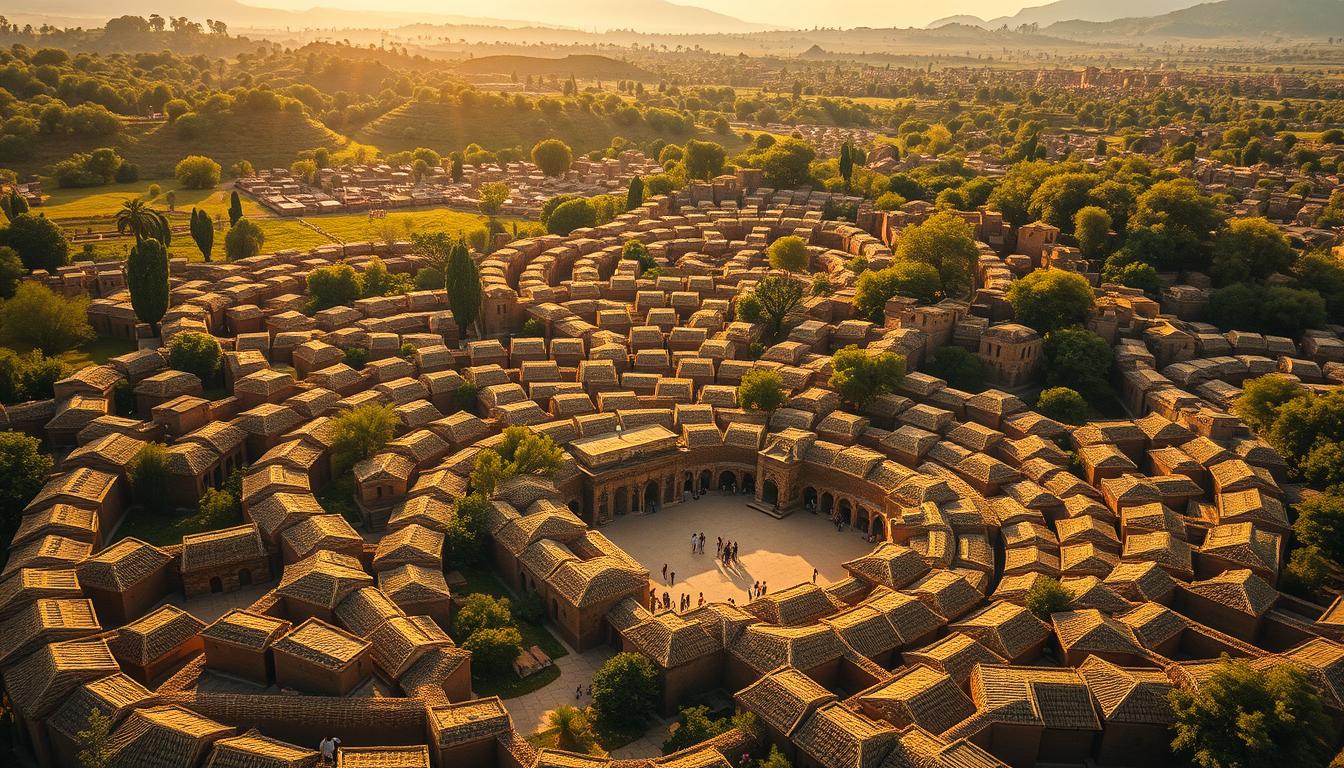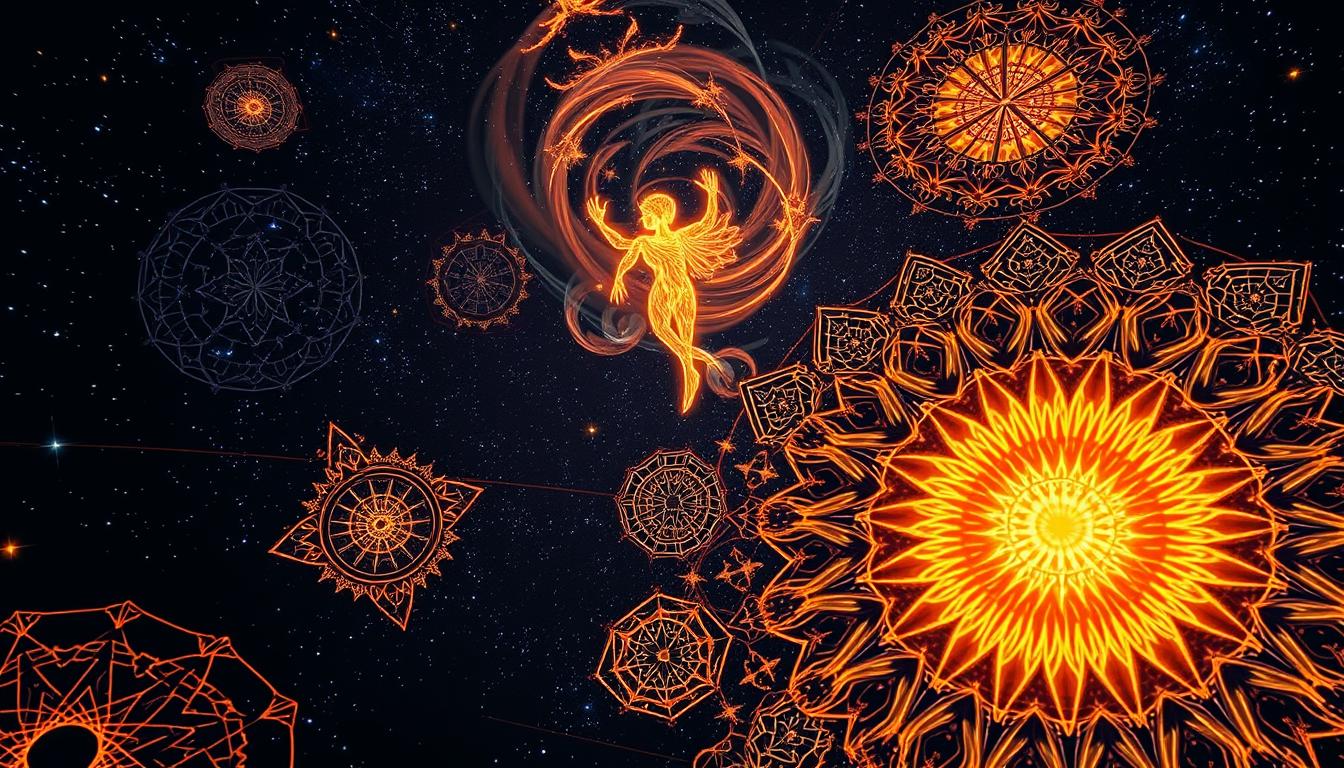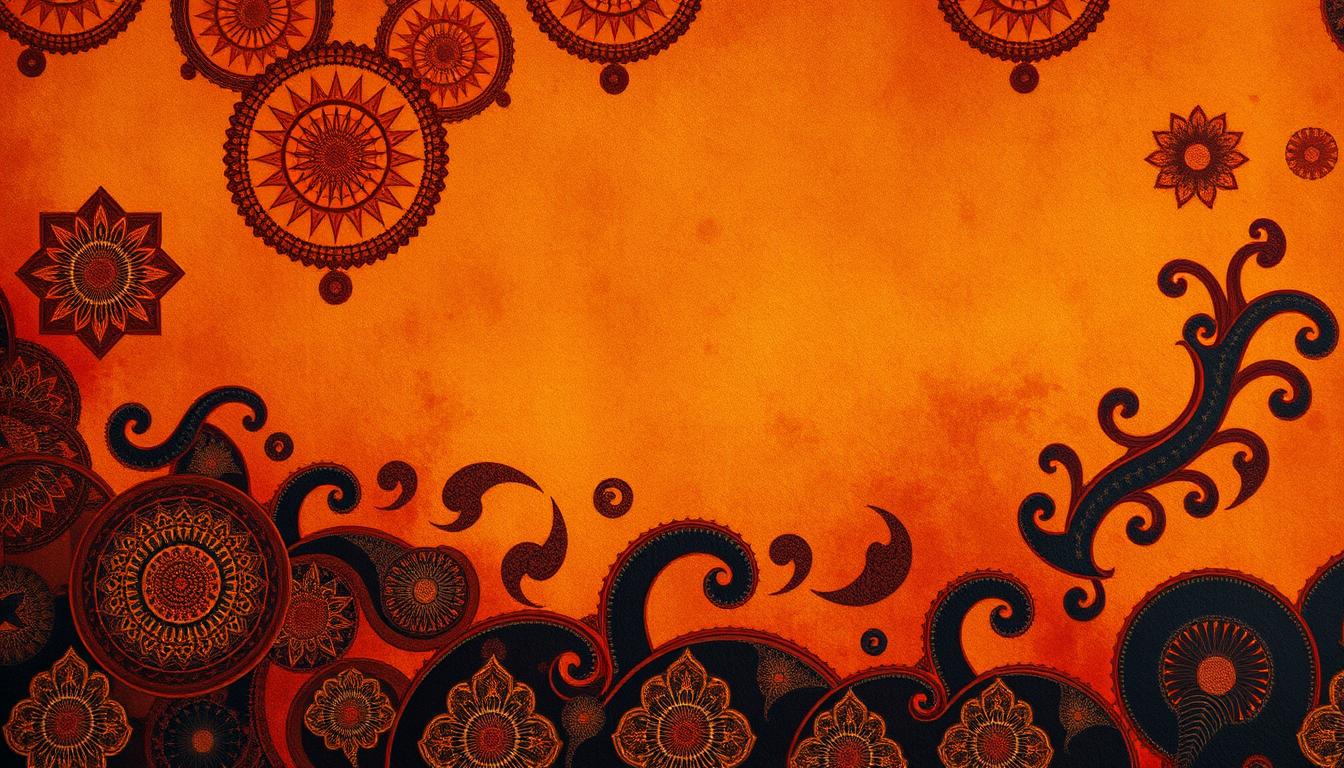Fractals are amazing mathematical patterns found in indigenous music and dance. They show complex shapes in these cultural forms. This study looks at how these patterns appear in traditional rhythms and moves.
Fractals are key in showing cultural identity through art and math. They make art more beautiful and connect us to the past of indigenous groups.
The Intersection of Mathematics and Cultural Expressions
Math and culture mix in deep, interesting ways. Indigenous cultures show this through their lively music and dance. These performances have patterns and rhythms that show math principles. It’s not always easy to see at first. In the past, people often saw art and math as totally separate. This view stopped us from fully seeing how they connect.
Working together, different fields can discover how math shapes cultural works. Experts in math and the arts now see music and dance as ways to explore complex ideas. They show how math shapes the way we create and understand culture. This helps us learn more about indigenous cultures.

Understanding Fractals: A Brief Overview
Fractals are more than just complex shapes. They are where art, nature, and math meet in an amazing way. Fractals have patterns that repeat forever, showing self-similarity at different sizes. This can be seen in nature and in things we make, making them really interesting.
Definition and Characteristics of Fractals
Fractals are beautiful because of their special characteristics. They include:
- Self-similarity: Patterns resembling themselves at different scales.
- Recursion: Infinite repetition of elements, creating depth and complexity.
- Irregularity: Natural forms that lack perfect geometric shapes embodying fractal mathematics.
These traits connect math with art, architecture, and nature.
The Mathematics Behind Fractals
Exploring fractals in math leads to ideas like scaling and shaping. Many mathematicians have added a lot to this field. They’ve come up with ways to create fractals. This shows how simple rules can create complicated and beautiful patterns, like in art and nature.
The Role of Fractals in Indigenous Music and Dance
Fractals in indigenous music and dance show deep meanings and cultural connections. These patterns are key in shaping performance stories. Artists use music and movement to tell their community’s beliefs and traditions.
In indigenous music, rhythms often have fractal features. They create patterns that connect generations. These rhythmic structures strengthen a sense of heritage. Similarly, indigenous dances use repeated steps to mirror nature and tell old stories.
Fractal elements showcase the skill in these art forms. They help people share and celebrate their heritage. By exploring these patterns, we see how art and identity are linked in indigenous cultures.
Fractal Patterns in African Music
Fractal patterns are deeply embedded in African music. They show the strong link between math and cultural ways of expression. Ron Eglash has done important research on this. He shows how fractal shapes appear in traditional rhythms. This research helps us see the close bond between art and math.
Insights from Ron Eglash’s Research
Ron Eglash’s research reveals that fractals are vital in African arts. He shows how repeating patterns appear in different cultural practices. This is very important for learning. Fractal symmetry in African music shows the deep math in melodies and tunes.
Recursive Patterns in Traditional Rhythms
Traditional African music has lots of repeating patterns. These patterns layer different beats, making a complete sound. Some examples are:
- Call and response techniques that echo fractal structures.
- Polyrhythmic cycles that show complex layering.
- Repetitive motifs that change as the piece goes on.
This lets listeners understand the math beauty in African music’s heritage.
Exploring Fractal Geometry in Native American Dance
Native American dance features complex movement patterns. These dances include circular motifs and spirals. They mirror shapes in nature, suggesting a mathematical connection in the choreography. Looking closely at these movements shows how the dances mix geometrical structures. This mix highlights both art and the deep cultural meaning of each performance.
The importance of these fractal patterns is big. They’re not just for looks. They tell stories, linking performers and viewers to a long history and tradition. By looking at how these geometric elements are used in dance, we can better understand the bond between art and math in Indigenous cultures.
Music as a Vehicle for Mathematical Understanding
Music education is key for better math understanding in kids. It shows how rhythm and identity link cultures and math. This part explains rhythm as a way to bring people together and share experiences.
The Significance of Rhythm in Cultural Identity
Rhythm is at the heart of cultural expression, bringing people together. It shows us the role of rhythm in music and math. Through patterns, it builds community and keeps traditions alive among the young.
Case Studies of Youth Engagement in Music and Math
There are many ways music has helped kids learn math. These examples highlight teaching methods that connect with culture, such as:
- After-school programs blending drumming and math to simplify complex concepts.
- Workshops where students create music using math patterns, boosting creativity and thinking.
- Local music events that reveal the math in rhythm, enhancing involvement.
These strategies show that mixing music with math improves youth participation. They grow to love both subjects more.
Fractals in Indigenous Art and Their Connection to Music
Indigenous art shows culture vividly, often mixing with music to add deep meaning. Fractals make traditional crafts mirror sound visually. Looking into how fractals link art and music gives us deep insight into how cultures share their stories beyond just the basics.
Visual Representations of Sound Through Fractals
Art in indigenous cultures reflects life’s rhythms, as patterns in art follow music beats. Fractals in artwork create a bridge between seeing and hearing. These patterns echo music’s rhythms, offering a shared language that ties deeply to cultural identity. This connection helps keep cultural practices and community spirit alive through visual art.
The Role of Traditional Crafts in Cultural Transmission
Traditional crafts play a key role in sharing culture, carrying stories and knowledge. Fractal patterns in these crafts show how art holds history and identity. By handing down these crafts, they do more than save art skills. They also strengthen the bond between art, history, and community identity. This way, crafts become stories that keep cultural memories alive.
Translating Math into Movement: Choreographic Applications
Many choreographers blend math and dance in exciting ways, showing off moves inspired by math. They use fractal choreography as a main way to do this. This approach uses math ideas to shape and flow dances. They bring in things like scaling, repeating, and matching patterns. This makes dances that reflect the intricate beauty of fractal geometry.
Trying out new moves challenges old ideas about dance. Choreographers turn math concepts into dance moves that make you think and feel. This mixes well with how dancers express themselves on the spot. The blend of planned moves and spontaneous emotion makes performances stand out more.
Some dances inspired by fractals show how deep choreography can get. By mixing math with dance, these shows start a special conversation. They turn complex math ideas into eye-catching dances. This keeps drawing interest from many areas, bringing together artists and mathematicians.
Collaborative Work Between Mathematicians and Dancers
Mathematics and movement together open doors to new ways of thinking and creating. Working together, mathematicians and dancers can take hard-to-grasp ideas and make them clear by acting them out. These team projects reveal the magic of fractals, making it easier to see how strict numbers and free-flowing dance moves can mix.
Interdisciplinary Projects Highlighting Fractals
There are many cool projects that mathematicians and dancers have done together. They often show off fractals in ways that get you thinking through dance. Here’s what makes these projects stand out:
- Innovative choreography: Dancers use fractal ideas in their performances, helping people see math in action.
- Workshops and performances: These events bring people together to see how math and dance can blend, sparking interest in both fields.
- Research initiatives: These collaborations can lead to studies and talks that look into how these projects help in learning and the arts.
By joining forces, mathematicians and dancers don’t just add to their own areas. They also open up new ways for us to see and create art that’s rooted in complex math concepts. This journey into fractals shows just how much creativity is possible when we blend careful study with free expression.
Conclusion
As we wrap up our journey into fractals, indigenous music, and dance, we see these elements are more than numbers and steps. They play a key role in how cultures express and preserve their identity. The complex rhythms and dances of various peoples embody a profound grasp of fractals.
The learnings from this piece highlight the need to value how fractals in indigenous arts guide educational insights. They bridge gaps between math and cultural art, creating learning that spans different fields. This blend not only honors traditional arts but also makes math learning relevant to culture.
Looking ahead, exploring how math intertwines with cultural traditions offers exciting research possibilities. Further study could reveal how fractals in indigenous arts foster community connections and respect for diverse cultures. This research can deepen our understanding of the ties that bind different cultures together.



